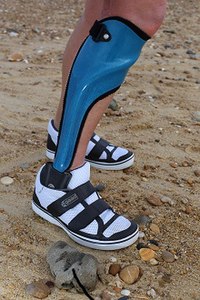
Photo from wikipedia
ABSTRACT Background: Children with cerebral palsy (CP) show age-driven development and individual fluctuations in walking capacity. Aim: 1. To precisely quantify 1MWT changes in children with CP, GMFCS level 1… Click to show full abstract
ABSTRACT Background: Children with cerebral palsy (CP) show age-driven development and individual fluctuations in walking capacity. Aim: 1. To precisely quantify 1MWT changes in children with CP, GMFCS level 1 and 2, generating 1MWT percentiles, depicting expected development over 6 months; 2. to assess the effect of a 6-month rehabilitation using whole-body vibration (WBV). Methods: Retrospective data analysis in 210 children with CP, GMFCS 1 and 2 who received standardized rehabilitation (DRKS00011331). 1MWT was assessed before (M0) and after treatment (M6), and at a 6-month follow-up (M12). Centiles were created using the lambda-mu-sigma method. Cohen’s d was used to assess effect size. Results: We created 1MWT percentiles using data of all 210 children (M0 data). A small treatment effect size (d = 0.46) was found (M6 and M12 data). Conclusions: Using the generated centiles clinicians may monitor 1MWT changes over 6 months. Combining WBV and conventional physiotherapy may improve 1MWT in children with CP. Abbreviations: 1MWT: One-Minute Walk Test; 6MWT: Six-Minute Walk Test; CP: Cerebral palsy; ES: effect size; GMFCS: Gross Motor Function Classification System; GMFM-66: Gross Motor Function Measure 66; LOESS: Locally Estimated Scatterplot Smoothing; LMS: lambda-mu-sigma; SD: standard deviation; WBV: whole-body-vibration.
Journal Title: Developmental Neurorehabilitation
Year Published: 2019
Link to full text (if available)
Share on Social Media: Sign Up to like & get
recommendations!